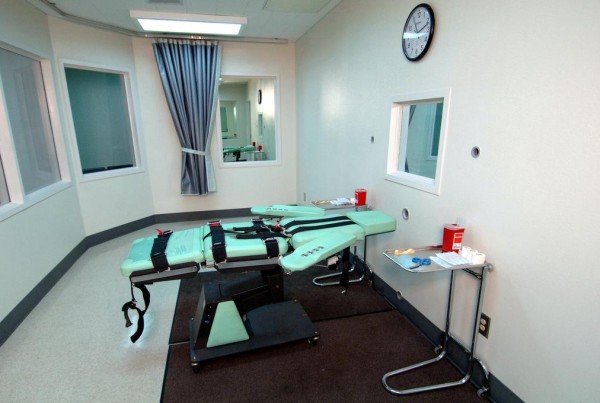Many have expressed concern and outrage over the way police treat citizens, especially African-Americans and other minorities. The Black Lives Matter movement began in response to the deaths of African-Americans in police custody, including Michael Brown in Ferguson, Missouri, and the arrest of Sandra Bland, who was later found dead in a Waller County jail, an apparent suicide.
The Austin American-Statesman has been investigating a different kind of fatal police encounter that has often been overlooked. Eric Dexheimer, a reporter with the Statesman says a surprising number of deaths in police custody were not the result of gunshots. The newspaper investigated deaths that occurred while an individual was under police restraint. He says more than 250 people died in Texas under these circumstances between 2005 and 2016.
Dexheimer says that people who are restrained by police are often under the influence of drugs, and that drugs are often identified as the cause of in-custody death. But in other cases, being restrained led to death or injury.
“Some of the big [trends] we saw though were the actual restraint itself, restraint technique, or the act of the restraint coupled with some exertion,” Dexheimer says. “We saw tasers were implicated in eight of these, I think, and then another four were indirectly implicated. Which is kind of surprising because [a] taser is considered a non-lethal weapon. Or they like to say a less lethal weapon. But it’s not often that you see a medical examiner say a taser is implicated in some of these deaths.”
Nearly 50 people died of ‘excited delirium,’ Dexheimer says.
“Excited delirium is a controversial – I’ll call it a diagnosis – but a designation in the medical community,” he eays. “It’s not accepted by all medical bodies but police, some medical examiners…emergency physicians, but not all other physicians, recognize it as a constellation of symptoms that usually revolve around drugs, physical exertion, and almost always police restraint.”
Dexheimer says excited delirium occurs almost exclusively when individuals are in police custody, and that it is listed as a cause of death mostly in cases involving black and Hispanic men.
“That was one of our findings,” Dexheimer says. “I think it was in about 83 percent of the cases where a medical examiner said that a person had died of excited delirium, it was a black or Hispanic man.”
Facts In Dispute
The first story in the Statesman’s ongoing investigation of in-custody deaths focuses on Graham Dyer, an 18-year-old from Paris, Texas, who died in police custody in August 2013.
Dexheimer says Dyer’s parents got a call from Mesquite police, telling them that the young man was in the hospital with serious injuries.
“[Dyer’s parents] said that the police were there, and they would not let them see their son because they said that he had been charged with a felony and he was in serious trouble,” Dexheimer says.
Kathy and Robert Dyer obtained police documents that said Graham Dyer had been on a bad LSD trip, and had been taken into custody by officers at a Mesquite junior high school wher he had been behaving bizarrely. The documents said Graham Dyer had bitten an officer while in custody
“They took him in the police car to the jail,” Dexheimer says. “And in the course of them taking him there, he threw himself around the back of the police car. And the police said he had injured himself so badly by hitting his head against the inside of the car that his head injuries caused his death.“
Dexheimer says Dyer’s parents accepted the police account of what happened, but that they had questions.
“They noticed that their son had some scratches on [his] arms that they didn’t understand,” hs says. “There was a doctor they said told them that Graham had been the victim of an assault.”
The Dyers were denied access to police investigative files, and videos that had been taken during their son’s time in custody, Subsequently, Kathy Dyer contacted the FBI, which she learned would investigate cases of civil rights violations. The FBI told the Dyers they could not investigate their son’s death.
“It occurred to Kathy one night that if the agency had looked into it, they must have gotten some of the records,” Dexheimer says. “They must have gotten some of the videos and the reports. And so she thought ‘what if I ask the FBI for it instead of the Mesquite police department?’
After a Freedom of Information Act request, the FBI sent the Dyers videos from the incident, including dash cam footage of the arrest scene, and videos of the back of the police cruiser in which Graham was transported, and another of his arrival at the jail.
“There were a couple of things that did not jibe with what the Dyer family heard from the police,” Dexheimer says. “You can see a hand reach in with a taser, and it tases Graham in the leg. And then pulls back and very clearly, it appears to be deliberately, th taser is placed into his groin area, and he is tased there. It looks like a couple of times on purpose.”
Dexheimer says the Mesquite police report of the incident is not consistent with the videos released to the Dyers.
“One expert I spoke to said there are at least a couple of things about this that don’t makes sense,” Dexheimer says. “One is, why would you try to hurt a person with a taser – to try to gain compliance when that person is already doing his best to hurt himself?”
Dexheimer says experts he talked to also questioned why police would not have done a better job restraining Dyer if he was injuring himself, and why he would not have been taken to a hospital.
The video of Graham Dyer arriving at the jail indicates he was not resisting officers.
“He looks very limp, certainly not combative,” Dexheimer says. “In their reports to the Attorney General’s office, which collects these custodial death reports, the police department said that they had to put him in a restraint chair in order to keep him under control. What the video shows, which appears to be somewhat different than that, is that he is very non-combative, and appears almost unresponsive. “
Written by Shelly Brisbin.

















